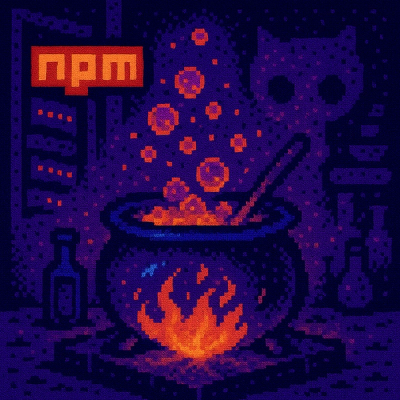
Research
/Security News
9 Malicious NuGet Packages Deliver Time-Delayed Destructive Payloads
Socket researchers discovered nine malicious NuGet packages that use time-delayed payloads to crash applications and corrupt industrial control systems.
pivot-form
Advanced tools
Pivot a single row of data 90 degrees counter-clockwise, placing the table headers to the left of the inputs implicitly creating a lovely form. This program takes that concept to the next level by allowing that pivoted row schema to be defined in spectacular number of configurations.
You can define not only the hierarchy and types of fields, but attach events, change styles, setup asynchronous data and much more all from a lightweight JSON schema object, no DOM, JavaScript or HTML required.
This allows the creation of complex, granular, and language agnostic UI definitions.
Applications include.
Currently pivot-form is pre-alpha software. Meaning we use it in production on a daily basis.
There is little or no documentation, more will come as the program matures. Formal documentation will follow.
Take row data
data = {column1: 'foo', column2: 'bar'}
schema = [
{
name: 'column1'
},
{
name: 'column2'
}
]
And turn it into an extensible form.
var form = document.createElement('pivot-form');
form.schema = schema;
form.data = data;
document.body.appendChild(form);
Listen for changes.
form.addEventListener('change', function (e) {
console.log(e.data);
});
Use built in UI widgets
schema = [
{
name: 'column1',
type: 'date'
},
{
name: 'column2',
type: 'time'
}
]
Use tab widgets
schema = [
{
type: 'tabs',
tabs: [
{
name: 'tab1',
schema: [
{
name: 'column1',
type: 'date'
}
]
}
]
}
]
Output data is flattened into a single data object (row) dependent on the UI objects defined in the schema. Data input is assigned to UI objects defined in the schema in the same way. So no matter how complex your schema, it will always map back down to a single object.
Schema is a collection (array) of header objects.
In its most simple state, a header consists of a single column name. In some cases name is even optional.
{
name: 'column1'
}
Type string is implicit. It will get you a single text field with a label that matches the name of the field.
{
name: 'column1',
type: 'string'
}
You can change type into all sorts of things. A complete list is provided at the end of this document.
Depending on what type you set, other properties will become available to the header object.
For example, the select type has the additional property enum that represents the data in the drop down.
{
name: 'column1',
type: 'select',
enum: [1, 2, 3]
}
You can pass enum a 2D array for value/innerHTML e.g.: [[1, 'one', 2, 'two']]
or pass enum a function or async function that returns such an array.
Some types are more complex because they can contain schemas.
{
type: 'tabs',
tabs: [
{
name: 'Tab 1',
schema: [
{
name: 'column1'
},
{
name: 'column2'
}
]
}
]
}
Container types like tabs and split-container can contain other containers as well, creating truly complex forms.
{
type: 'tabs',
tabs: [
{
name: 'Tab 1',
schema: [
{
type: 'split-container',
panel1: {
title: 'Set 1',
mode: 'fieldset',
schema: [
{
name: 'column1'
},
{
name: 'column2'
}
]
},
panel2: {
title: 'Set 2',
mode: 'fieldset',
schema: [
{
name: 'column3'
},
{
name: 'column4'
}
]
}
}
]
}
]
}
Initial data can be set within the schema:
{
name: 'column1',
value: 'Default value'
}
Initial data can be a primitive type like string or number, or it can be a function that returns a primitive type.
{
name: 'column1',
value: function () {
return 'Default value';
}
}
You can also use asynchronous callbacks to define initial values.
{
name: 'column1',
value: function (callback) {
setTimeout(function () {
callback('Default value');
}, 1000);
}
}
Even if it takes time for your initial values to populate, data will not be set to the form until all fields are done initializing. Data set prior to initialization is set aside until after initialization is complete, then set, transparent to the implementor and user.
There are a few properties that all headers contain.
events
labelEvents
style
containerStyle
labelStyle
Events and styles are defined as objects:
{
click: function (e) { console.log('this was clicked'); }
}
{
style: { border: 'solid 1px black' }
}
Other properties in the header are passed though as attributes to the element, for example:
{
foo: 'bar'
}
results in the HTML
<input foo="bar">
Note: per the W3C specification, attributes can only contain strings.
Setting data at runtime is (supposed to be) painless. Data is a getter/setter, data's properties are getter/setters.
Setting data runs through a very complex path of code that ensures that all components that are supposed to receive data updates from the data you set get the data, while other components do not.
You are allowed to have components (headers) that contain the same name. In this case, setting data will update both components. Similarly, changing data in one will also cause a change to the other due to the way the data setter/getters are written.
What this means you you is you can set data three ways:
Using a full dataset:
form.data = {foo: 'bar', baz: 'wiz'}
Using a partial dataset:
form.data = {foo: 'bar'} // baz field will not be effected
Using a property getter:
form.data.foo = 'bar';
As with initial value settings, you can use primitive values, or you can use a function.
form.data.foo = function () { return 'bar'; };
Due to the shared code paths with the initialization phase, the function can be asynchronous as well.
form.data.foo = function (callback) { setTimeout(function () { callback('bar'); }, 1000); };
You can subscribe to the events using addEventListener
form.addEventListener('changed', function () { console.log(form.data); });
These functions will probably be private at a later date:
When a schema is passed into the pivot-form, each header object creates a "component" which is a distinct field maybe (if it has a name) linked to the data getter/setter. You can get at these components at runtime by calling the following functions:
block (default), dialog or fieldset (like block with a nifty border and title). All produce really cool useful forms. You can change this property at runtime, but why would you?dialog and fieldset modes.childForms property recursively to find all still initializing components. Future versions will simplify this.moveable: true.tag to control tag name)FAQs
Schema based hierarchical form component.
The npm package pivot-form receives a total of 0 weekly downloads. As such, pivot-form popularity was classified as not popular.
We found that pivot-form demonstrated a not healthy version release cadence and project activity because the last version was released a year ago. It has 1 open source maintainer collaborating on the project.
Did you know?

Socket for GitHub automatically highlights issues in each pull request and monitors the health of all your open source dependencies. Discover the contents of your packages and block harmful activity before you install or update your dependencies.

Research
/Security News
Socket researchers discovered nine malicious NuGet packages that use time-delayed payloads to crash applications and corrupt industrial control systems.

Security News
Socket CTO Ahmad Nassri discusses why supply chain attacks now target developer machines and what AI means for the future of enterprise security.

Security News
Learn the essential steps every developer should take to stay secure on npm and reduce exposure to supply chain attacks.